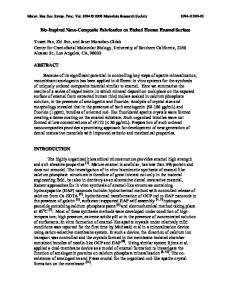Protein-based nano-structure fabrication in aqueous solution: Bio Nano Process
- PDF / 2,369,278 Bytes
- 7 Pages / 612 x 792 pts (letter) Page_size
- 41 Downloads / 296 Views
Protein-based nano-structure fabrication in aqueous solution: Bio Nano Process Ichiro Yamashita Graduate School of Materials Science, Nara Institute of Science and Technology 8916-5 Takayama-cho Ikoma, Japan. ABSTRACT A new nano-fabrication process, utilizing protein supramolecules, biomineralization, and nanoetching was proposed, which was named Bio Nano Process (BNP). The main processes of the BNP include the nanoparticle (NP) or nanowire (NW) synthesis utilizing bio-template (biomineralization) and nanostructure fabrication utilizing self-organization of protein supramolecules. Proteins are so designed to produce the final structures. The space where nano functional structures are fabricated is named an “Active Bio-field”. It was proven that the process has vast potential to be applied to a wide range of quantum effect base nano-devices and thin film devices. INTRODUCTION Study on the nanometric device is now the hottest research fields and bottom-up technology is believed to play an essential role in fabricating nanodevices. The assessment of the proteins from the nanotechnology points of view reveals that proteins are ideal nano-blocks for fabricating inorganic functional nano-structures of nanodevices. That is 1) the same structure down to atomic scale, 2) self-assembly ability, 3) selective deposition of inorganic materials (biomineralization), 4) vulnerable compared to inorganic materials. Taking advantage of these characteristics, a biological method to make inorganic nanofunctional structures was proposed. Namely proteins are used as scaffolds to fabricate inorganic functional nanostructures on the architecture produced by the top-down method, which was named Bio Nano Process (BNP) [1].
Figure 1. Some target nano-structures of the Bio Nano Process.
RESULTS & DISCUSSION Biomineralization: Nanoparticle Synthesis in a cage-shaped protein We have developed a process which produces homogenous nanoparticle (NP) in apoferritins or Lis-Dps. The outer and inner diameters of apoferritin are 12 and 7 nm respectively [2]. LisDps has the outer and inner diameter of 9.5 nm and of 4.5 nm [3]. The inner cavity was used as a spatially restricted chemical chamber for artificial biomineralization of metal, semiconductor, and oxide material NP. Since the cavity size was determined by the DNA information, the shape and size of the cavity is atomically the same. Therefore, NPs synthesized have the same size, which is ideal for the applications. The NP biomineralizatin process is simple. Solution containing cage-shaped protein and source ions was incubated for a designated period. Source ions were introduced into the cavity and NPs are selectively formed inside the protein shell. The details of the NP biomineralization mechanism are not yet clear. But, it is generally accepted that the collection of negatively charged amino acid residues on the inner surface and three-fold channel play an important role for sucking in source ions and nucleation. So far, more than 15 kinds of NPs were synthesized in the cage-shaped protein sup
Data Loading...









